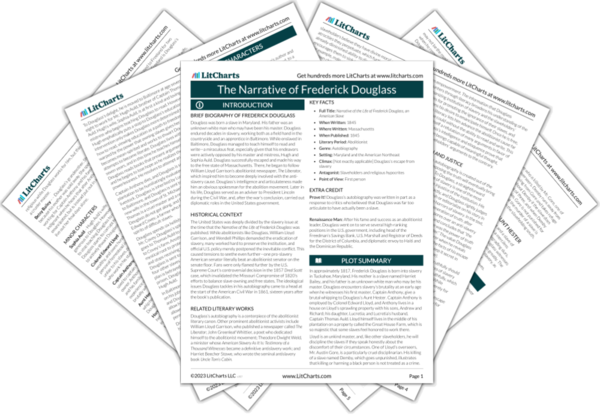Summary
Analysis
Mr. Hopkins, the more humane overseer, is quickly replaced by Mr. Austin Gore. Gore is sadistic and prideful, and he can twist any action into a punishable act of impudence. According to Douglass, Gore lives by the maxim, “It is better that a dozen slaves should suffer under the lash, than that the overseer should be convicted, in the presence of the slaves, of having been at fault.” Ironically, Gore mercilessly debases the slaves, then turns around and grovels before his own master.
Gore illustrates the self-perpetuating hypocrisy of slaveholding culture. He makes no attempt to mask the fact that he punishes slaves even when they are not at fault. Gore’s groveling before his master illustrates the way that those who abuse slaves are themselves forced into degrading interactions.
Themes
Quiz
Test Yourself
Gore once began to whip one of Colonel Lloyd’s slaves named Demby. Demby runs into a creek to ease the burns of the lash and refuses to come out. Gore draws his rifle and tells Demby that he will shoot him if the slave doesn’t comply. After three calls, Gore does not hesitate to shoot and kill Demby.
Demby’s justified disobedience, and Gore’s harsh retaliation, are yet another example of the grave consequences slaves face simply for acting like rational humans.
Themes
Quiz
Test Yourself
Gore defends his murder of Demby to Colonel Lloyd as a necessary means of setting an example, as Demby had become “unmanageable.” Lloyd finds his explanation satisfactory and Gore is allowed to retain his position without even being investigated for his crime, and his fame as an overseer spreads.
When a slave has been wronged, the white establishment does not even pretend to carry out justice—just as they fail to investigate Gore in the death of Demby.
Themes
Quiz
Test Yourself
Douglass observes that killing a black person, slave or free, is not treated as a crime in Talbot, Maryland. Douglass recalls several brutal murders of slaves, all of which went unpunished: Thomas Lanman killed two slaves and boasted of his actions, and Mrs. Giles Hicks beat an adolescent female slave to death.
Demby’s death, along with Douglass’s other anecdotes, symbolizes how little blacks’ lives are valued.in the slaveholding south.
Themes
Quiz
Test Yourself
Get the entire Narrative of Frederick... LitChart as a printable PDF.

Lastly, Douglass recounts the story of Colonel Lloyd’s neighbor, Mr. Beal Bondly, who killed one of Lloyd’s slaves for accidentally crossing onto his property. Bondly visited Lloyd’s the next day and nothing came of the murder. Douglass concludes with the observation that “it was a common saying, even among little white boys, that it was worth a half-cent to kill a ‘nigger,’ and a half-cent to bury one.”
Slaves are not viewed as morally valuable entities—they are nothing more than financial. This mindset causes slaveholders to deal with slaves unjustly.
Themes
Quiz
Test Yourself












